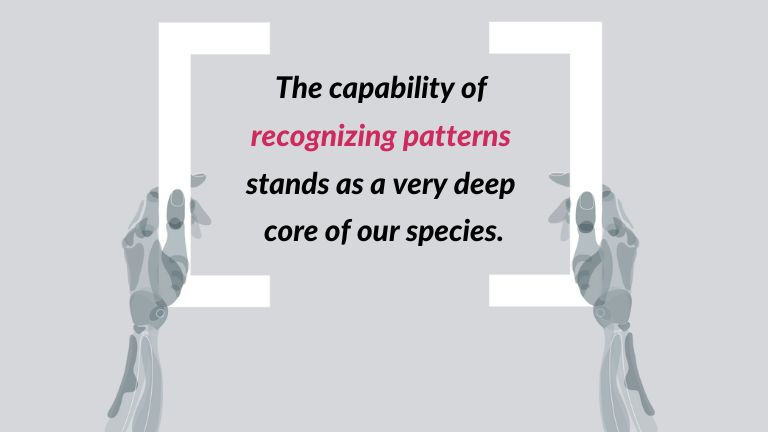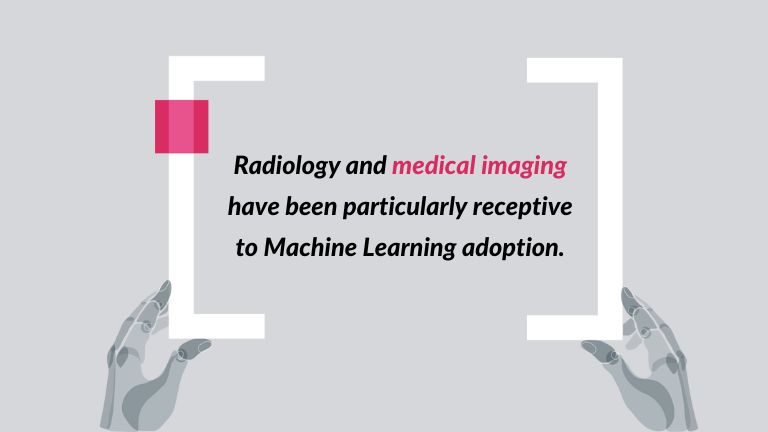Development of medical imaging software. The patterns
The development of medical imaging software remains one of the fastest growing AI fields in medicine. These applications have made significant strides in areas such as image analysis, enhancement, and visualization, as well as in planning and evaluating surgical and radiation treatments. But how did it all start – and why?
The exclusive capability of recognizing patterns?
In this journey we will not dwell on the distant past. We won’t even return to 1895, when Wilhelm Roentgen discovered a “new kind of ray”. What is much more interesting is the question about patterns and their application to the development of medical imaging software.
The neocortex, one of the layers of the mammal’s brain, is responsible for the ability to recognize patterns. Ray Kurzweil suggested provocatively that as human beings we have only a weak ability to process logic. But the capability of recognizing patterns stands as a very deep core of our species. Robert Goldstone went even further, proving that it is the only differences between man and machines. We do better in pattern recognition [1]. Indeed, sixteenth-century astronomical data enabled Kepler’s laws, foundational for classical mechanics. Likewise, identifying patterns in atomic spectra was crucial for the theories of quantum physics.
Yet, here comes the statistics.
Pattern matching. Making decisions based on data
Even though the concept of pattern recognition is encrypted in the structures of our brain, before the 1960s only statisticians exploited it as an output of their theoretical research. However, the 60’ marked a pivotal period in the evolution of pattern recognition thanks to key statistical contributions. Probability Theory provided a mathematical framework for modeling patterns and their variations. Statistical decision theory offered a systematic approach to making decisions based on data. Finally, Bayesian Statistics enabled the updating of beliefs about patterns as new information becomes available.
The turning point in our journey arrived in the 1960’s, when engineering students started working on the Stanford Cart. The robot was designed to assist in studying how to control a vehicle remotely using only visual data. Researchers spent many years improving its capabilities, eventually transforming a robot into an autonomous machine. It had the ability to avoid objects, which also means it exploited pattern recognition and decision tree to draw conclusions about a set of observations.

Machine learning through experience and patterns
Decision trees, derived from Bayesian Statistics, are obviously not an ancient history… in the story of the development of medical imaging software. They are widely used in machine learning due to their ease of understanding and implementation. In 1979 Students at Stanford University presented final version of Stanford Cart, but in parallel, extraordinary experiments were happening in the world of engineering and mathematics.
In 1952 a computer program learned to play checkers, improving its skills through experience (experience = more patterns). Just five years later, the first neural network was created, mimicking human thought processes. By 1967, computers were making basic decisions based on patterns, such as finding the shortest route between cities. In the mid-80s, a computer program learned to pronounce words like a human child, and by the late 90s, computers had surpassed human champions in chess…
The core of the development of medical imaging software
Pattern recognition is the core technology behind the development of medical imaging software, called also computer-aided diagnosis (CAD) systems. Radiology and medical imaging have been particularly receptive to ML adoption due to several factors. We won’t analyze all of them, however the key lies in the specificity of this field of medicine. It generates vast amounts of image data daily, providing rich training material for AI algorithms. Moreover, medical images often adhere to standardized formats, facilitating data analysis.
AI-enabled tools analyze X-rays, MRIs, and CT scans for abnormalities linked to diseases. Eventually, by studying datasets, algorithms learn to recognize patterns associated with specific health conditions. Some of the disease-related features can be visible by human eye. And some of them – cannot. A great example here is radiomics, a method that has a great potential to impact the future landscape of digital healthcare. But that is a whole different story to tell.

Development of medical imaging software – but why?
The development of medical imaging software seems to be an essential component of the entire health-care continuum nowadays. The surge in imaging data, fueled by increased testing and electronic health records is a pattern that surpassed human interpretation capacity.
This must lead to a rise in medical errors and radiologist burnout. Of course, while some increased imaging volumes is justified by new medical knowledge, there’s a growing overreliance on tests, diminishing the importance of physical exams. And that is the status quo we need to face.
Nevertheless, imaging studies have become the fastest-growing medical service in the world [2]. Fortunately, the aforementioned Robert Goldstone was probably not entirely correct. Machines and algorithms, just like humans, can recognize patterns. At least when it comes to analyzing medical images.
References:
[1] Üstün, B. (2024). Patterns before recognition: The historical ascendance of an extractive empiricism of forms. Humanities and Social Sciences Communications, 11(1), 1-9. https://doi.org/10.1057/s41599-023-02574-1
[2] Bercovich E, Javitt MC. Medical Imaging: From Roentgen to the Digital Revolution, and Beyond. Rambam Maimonides Med J. 2018 Oct 4;9(4):e0034. doi:10.5041/RMMJ.10355. PMID: 30309440; PMCID: PMC6186003.